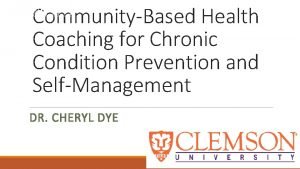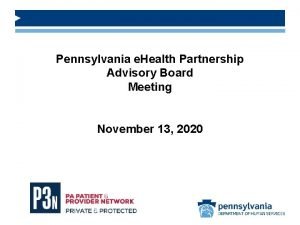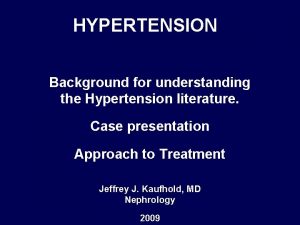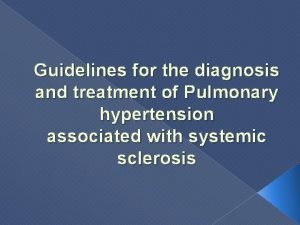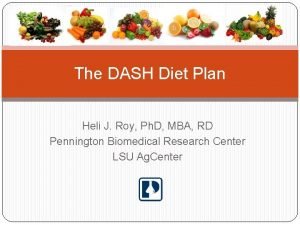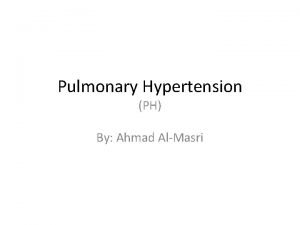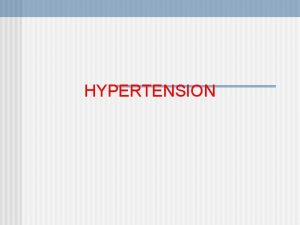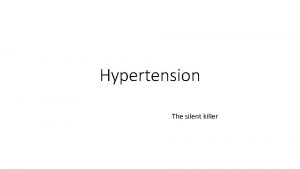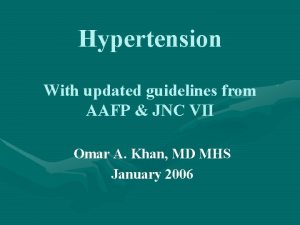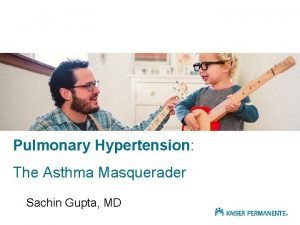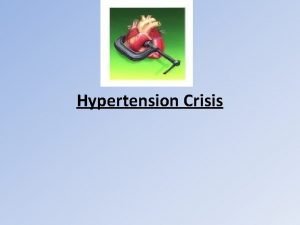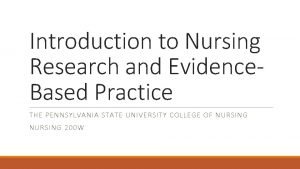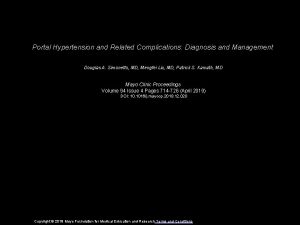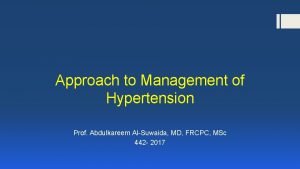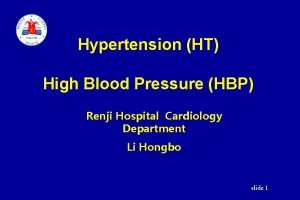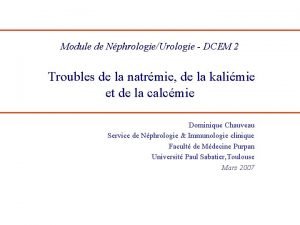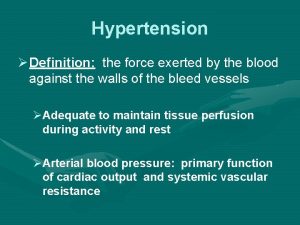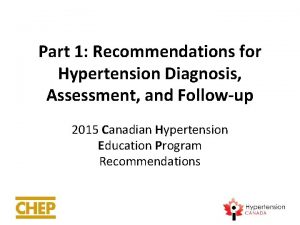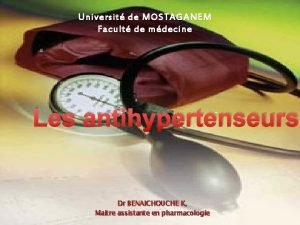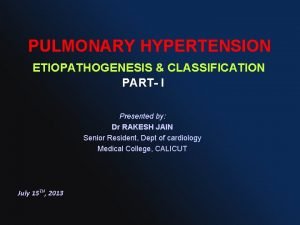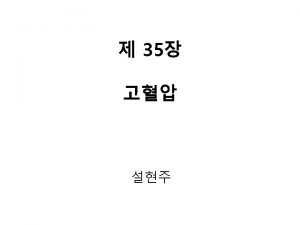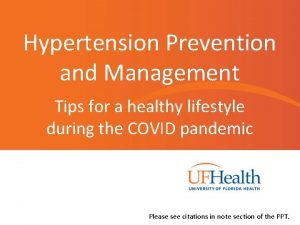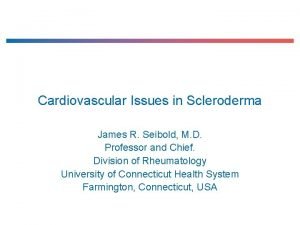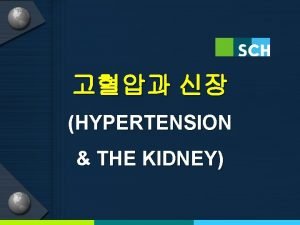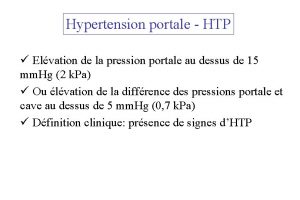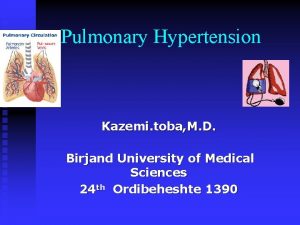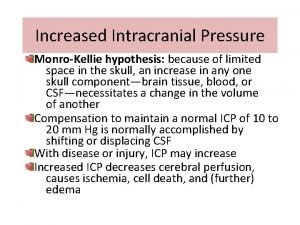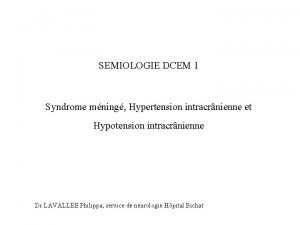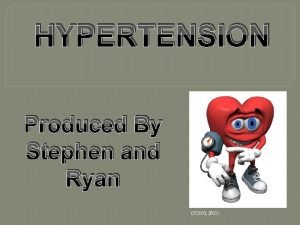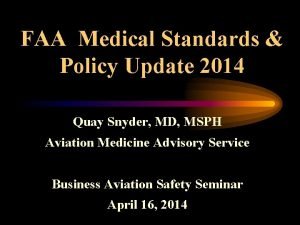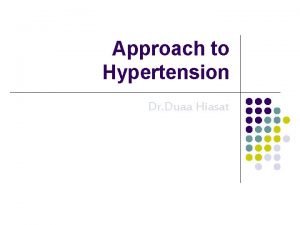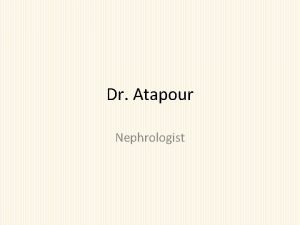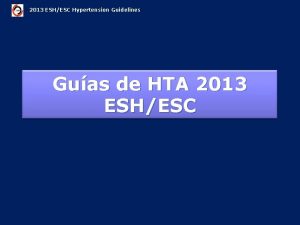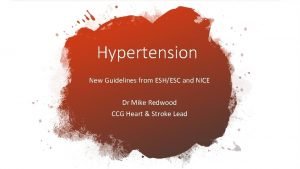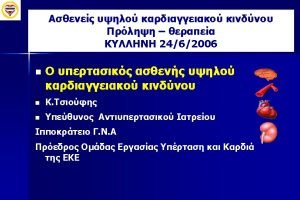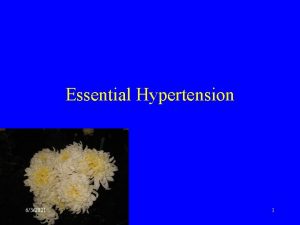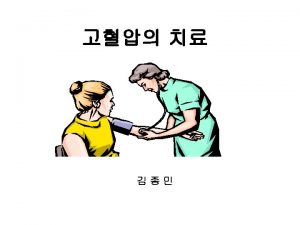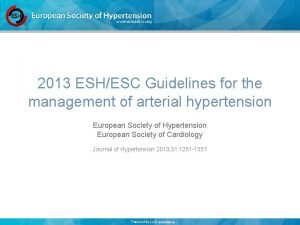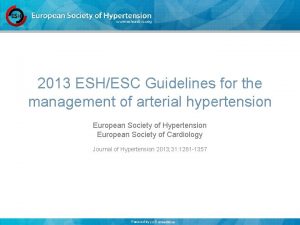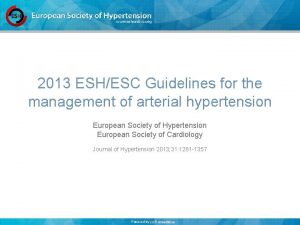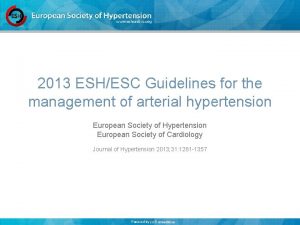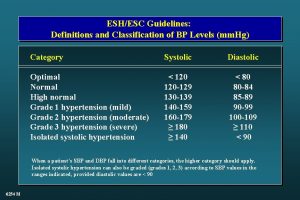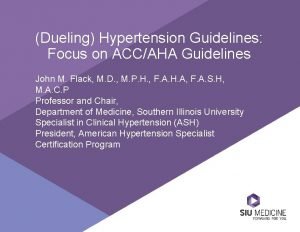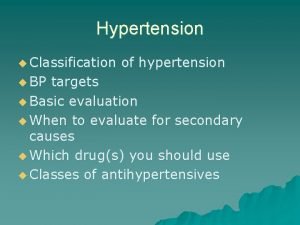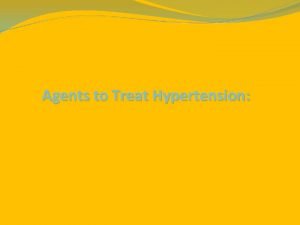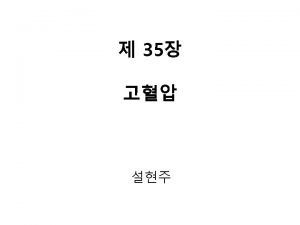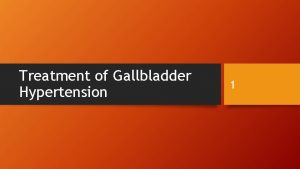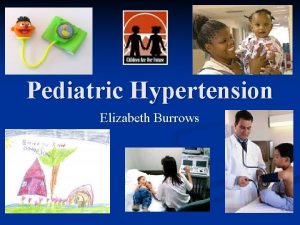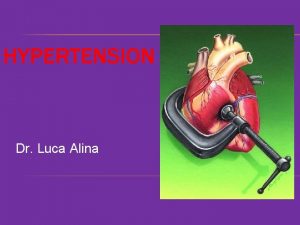2013 ESHESC Hypertension Guidelines 2013 ESHESC Guidelines for









































- Slides: 41

2013 ESH/ESC Hypertension Guidelines 2013 ESH-ESC Guidelines for the Management of Arterial Hypertension

2013 ESH/ESC Hypertension Guidelines Journal of Hypertension 2013 European Heart Journal 2013 Blood Pressure 2013

2013 ESH/ESC Hypertension Guidelines Levels of evidence

2013 ESH/ESC Hypertension Guidelines Classes of recommendations

2013 ESH/ESC Hypertension Guidelines Definitions and classification of office blood pressure levels (mm. Hg) No changes

2013 ESH/ESC Hypertension Guidelines Definitions of hypertension by office and out-of-office blood pressure levels (mm. Hg) No changes

2013 ESH/ESC Hypertension Guidelines Search for asymptomatic organ damage, cardiovascular disease, and chronic kidney disease

2013 ESH/ESC Hypertension Guidelines Total cardiovascular risk assessment

2013 ESH/ESC Hypertension Guidelines Stratification of total CV risk in catefgories of low, moderate, high and very high risk

2013 ESH/ESC Hypertension Guidelines Blood pressure goals in hypertensive patients

2013 ESH/ESC Hypertension Guidelines Target BP for treatment - Other problems No direct evidence available on target out-of-office BP values (ambulatory / home) for treatment Linear relationship between BP reductions (clinic / outof-office) and markers of organ damage (LVH / proteinuria and microalbuminuria) over a wide BP range reported in several studies Prognostic significance of changes in organ damage still under debate

2013 ESH/ESC Hypertension Guidelines Target SBP < 130 mm. Hg at high / very high CV risk No clear / consistent evidence of CV event reduction also by subgroup / post-hoc data analysis No beneficial effects on risk of ESRD in nephropathic patients Although mainly based on post-hoc approach suspicion of a possible J curve phenomenon

2013 ESH/ESC Hypertension Guidelines Initiation of lifestyle changes and antihypertensive drug treatment

Recommendations-2007

2013 ESH/ESC Hypertension Guidelines Initiation of antihypertensive drug treatment

2013 ESH/ESC Hypertension Guidelines Choice of antihypertensive drugs Conclusions from 2013 (and 2003 and 2007) Guidelines The main benefits of antihypertensive treatment are due to lowering BP “per se” and are laragely independent of the drug employed Although meta-analyses occasionally claim superiority of one class for some outcomes this largely depends on selection bias of trials. The largest meta-analyses do not show clinically relevant betweenclass differences Current Guidelines reconfirm that the following drugs classes are all suitable for initiation and maintenance of antihypertensive treatment either as monotherapy or in some combinains with each other (IA) - Diuretics (thiazides / chlorthalidone / indapamide) - Beta-blockers - Calcium antagonists - ACE-inhibitors - Angiotensin receptor blockers

2013 ESH/ESC Hypertension Guidelines Choice of antihypertensive drugs 5. 2. 1. 8 Should antihypertensive agents be ranked in order of choice?

2013 ESH/ESC Hypertension Guidelines Arguments against classifying drugs in order of choice Major mechanism of the benefit of antihypertensive treatment is lowering of BP “per se” Effects on cause-specific mechanisms are similar or differ by only a minor degree between agents The type of outcome in a given patient is unpredictable All classes of antihypertensive agents have their advantages but also their contraindications

2013 ESH/ESC Hypertension Guidelines Arguments against classifying drugs in order of choice All-purpose ranking of drugs for general antihypertensive usage is not evidence-based Recommendations should advice on drugs to be preferentially considered (IIa. C) based on - use in trials on specific conditions - greater effectiveness on OD and risk factors - adverse effect (and risk of treatment discontinuation)

2013 ESH/ESC Hypertension Guidelines Combination treatment No matter which drug is employed, monotherapy can effectively reduce BP in only a limited number of hypertensive patients Most patients require the combination of at least two drugs to achieve BP control The issue is - whether combination treatment should always be preceded by a “monotherapy” attempt - whether and when it can be the initial approach

2013 ESH/ESC Hypertension Guidelines Two drug combinations as initial treatment Cons One of the two drugs may be ineffective Ascribing side effects more difficult Pros When one agent ineffective, finding an alternative monotherapy may be a painstaking process, adversely affecting compliance Prompter response in a larger number of patients (benefit in high risk patients? ) Lower drop-out rate

2013 ESH/ESC Hypertension Guidelines Major drug combinations used in trials of antihypertensive treatment in a step-up approach or as a randomized combination - 1

2013 ESH/ESC Hypertension Guidelines Major drug combinations used in trials of antihypertensive treatment in a step-up approach or as a randomized combination - 2

2013 ESH/ESC Hypertension Guidelines Preferred drug combinations Randomized comparisons between drug combinations / or monotherapy only in few trials (ADVANCE / FEVER / ACCOMPLISH) In all other trials - Treatment started with one drug / other drugs added - 2 nd-3 th … drugs chosen among those not used in other treatment arms

2013 ESH/ESC Hypertension Guidelines Preferred combinations With the exception of an ARB plus a CA (never systematically used in an outcome trial) all combinations were used in at least one active arm of placebo-controlled trials with significant benefit

2013 ESH/ESC Hypertension Guidelines Preferred combinations Evidence Class Level IIa C Other drug combinations should be considered and probably are beneficial in proportion to the extent of BP reduction However, combinations that have successfully been used in trails may be preferable

2013 ESH/ESC Hypertension Guidelines Fixed-dose (single tablet) combinations Evidence Class Level IIb B Combinations of two antihypertensive drugs at fixed doses in a single tablet may be recommended and favoured, because reducing the number of daily pills improves adherence which is low in patients with hypertension

2013 ESH/ESC Hypertension Guidelines Therapeutic intervention in White Coat Hypertension (WCH) No RCT has ever investigated whether BP-lowering drugs lead to CV event reduction Drug treatment may be considered if WCH is associated with - Dysmetabolic risk factors - Organ damage - Normal home with high ABP or viceversa In absence of the above intervention may be limited to lifestyle changes but this decision should be accompanied by a close FU (including periodical out-of-office BP measurements)

2013 ESH/ESC Hypertension Guidelines Antihypertensive treatment strategies in the elderly

2013 ESH/ESC Hypertension Guidelines Treatment strategies in hypertensive women

2013 ESH/ESC Hypertension Guidelines Treatment strategies in patients with diabetes

2013 ESH/ESC Hypertension Guidelines Treatment strategy in hypertensive patients with MS Lifestyle changes, particularly weight loss and physical exercise (IB) Antihypertensive agents potentially improving or at least not worsening insulin sensitivity (RAS blockers/CA) should be considered as the preferred drugs (IIa. C) Beta-blockers (with the exception of vasodilating betablockers) and diuretics should be considered only as additional drugs (IB) BP lowering drugs are not recommended in MS individuals with high-normal BP (IIIA)

2013 ESH/ESC Hypertension Guidelines Treatment strategies in hypertensive patients with nephropathy

2013 ESH/ESC Hypertension Guidelines Treatment strategies in hypertensive patients with cerebrovascular disease

2013 ESH/ESC Hypertension Guidelines Treatment strategies in hypertensive patients with atherosclerosis, arteriosclerosis, and peripheral artery disease

2013 ESH/ESC Hypertension Guidelines Treatment strategies in hypertensive patients with resistant hypertension

2013 ESH/ESC Hypertension Guidelines Treatment strategies in hypertensive patients with resistant hypertension

2013 ESH/ESC Hypertension Guidelines Can antihypertensive medications be stopped? In some patients in whom treatment is accompanied by an effective BP control for an extended period it may be possible to reduce the number/dosage of drugs This may be particularly the case if BP control is accompanied by healthy lifestyle changes, removing the environmental pressor influences Medication reduction should be gradual and patients should be frequently checked

2013 ESH/ESC Hypertension Guidelines Follow-up - Elevated BP at control visits Search for the cause(s) - Poor adherence - Persistence of a WC effect (repeated BP measurements) - Occasional or more regular consumption of drugs / substance raising BP or opposing antihypertensive effects (tactful / stringent questioning of patients / family) If responsible, ineffective treatment should be modified without delay to avoid clinical inertia

2013 ESH/ESC Hypertension Guidelines Gaps in evidence and need for future trials - 1 1) Should antihypertensive drug treatment be given to all patients with grade 1 hypertension when their CV risk is low-to-moderate? 2) Should elderly patients with a SBP between 140 and 160 mm. Hg be given antihypertensive drug treatments? 3) Should drug treatment be given to subjects with white-coat hypertension? Can this condition be differentiated into patients needing or not needing treatment? 4) Should antihypertensive drug treatment be started in the high normal BP range and, if so, in which patients? 5) What are the optimal office BP values (i. e. the most protective and safe) for patients to achieve by treatment in different demographic and clinical conditions? 6) Do treatment strategies based on control of out-of-office BP provide an advantage (reduced clinical morbidity and mortality, fewer drugs, fewer side-effects) over strategies based on conventional (office) BP control? 7) What are the optimal out-of-office (home and ambulatory) BP values to be reached with treatment and should targets be lower or higher in high risk hypertensives?

2013 ESH/ESC Hypertension Guidelines Gaps in evidence and need for future trials - 2 8) Does central BP add to CV event prediction in untreated and treated hypertensive patients? 9) Do invasive procedures for treatment of resistant hypertension compare favourably with the best drug treatment and provide long-term BP control and reduction of morbid and fatal events? 10) Do treatment-induced changes in asymptomatic OD predict outcome? Which measures—or combinations of measures—are most valuable? 11) Are lifestyle measures known to reduce BP capable of reducing morbidity and mortality in hypertensive patients? 12) Does a treatment-induced reduction of 24 h BP variability add to CV protection by antihypertensive treatment? 13) Does BP reduction substantially lower CV risk in resistant hypertension?
 Health coaches for hypertension control
Health coaches for hypertension control Hypertension
Hypertension Nursing management of portal hypertension
Nursing management of portal hypertension Hypertensive emergency vs urgency
Hypertensive emergency vs urgency Pulmonary hypertension
Pulmonary hypertension What is the dash diet
What is the dash diet Pulmonary hypertension definition
Pulmonary hypertension definition Malignant hypertension ppt
Malignant hypertension ppt Hypertension vs hypotension
Hypertension vs hypotension Bp
Bp Jnc 7 hypertension
Jnc 7 hypertension Sachin gupta md
Sachin gupta md Jnc 7 hypertension
Jnc 7 hypertension Case scenario for hypertension
Case scenario for hypertension Pico question examples labor and delivery
Pico question examples labor and delivery Dr douglas simonetto
Dr douglas simonetto Hypertensive emergency vs urgency
Hypertensive emergency vs urgency Morphology of hypertension
Morphology of hypertension Paedp echo
Paedp echo Traitement hypertension
Traitement hypertension Systemic vascular resistance
Systemic vascular resistance Rules of halves in hypertension
Rules of halves in hypertension Diagnosis hypertension
Diagnosis hypertension Presenting complaints of hypertension
Presenting complaints of hypertension Diueritique
Diueritique Pah groups
Pah groups Gestational hypertension
Gestational hypertension Aobp vs obpm
Aobp vs obpm American heart association 2020
American heart association 2020 Pulmonary hypertension differential diagnosis
Pulmonary hypertension differential diagnosis Ttp disease
Ttp disease Signe du flot genou
Signe du flot genou Hypertension
Hypertension Cushing's triad vitals
Cushing's triad vitals Signe de kernig
Signe de kernig Pratt's test for varicose veins
Pratt's test for varicose veins Conclusion of hypertension
Conclusion of hypertension Caci asthma worksheet
Caci asthma worksheet Malignant hypertension management
Malignant hypertension management Nursing blood pressure assessment
Nursing blood pressure assessment Causes of secondary hypertension
Causes of secondary hypertension Stages of pulmonary hypertension
Stages of pulmonary hypertension
